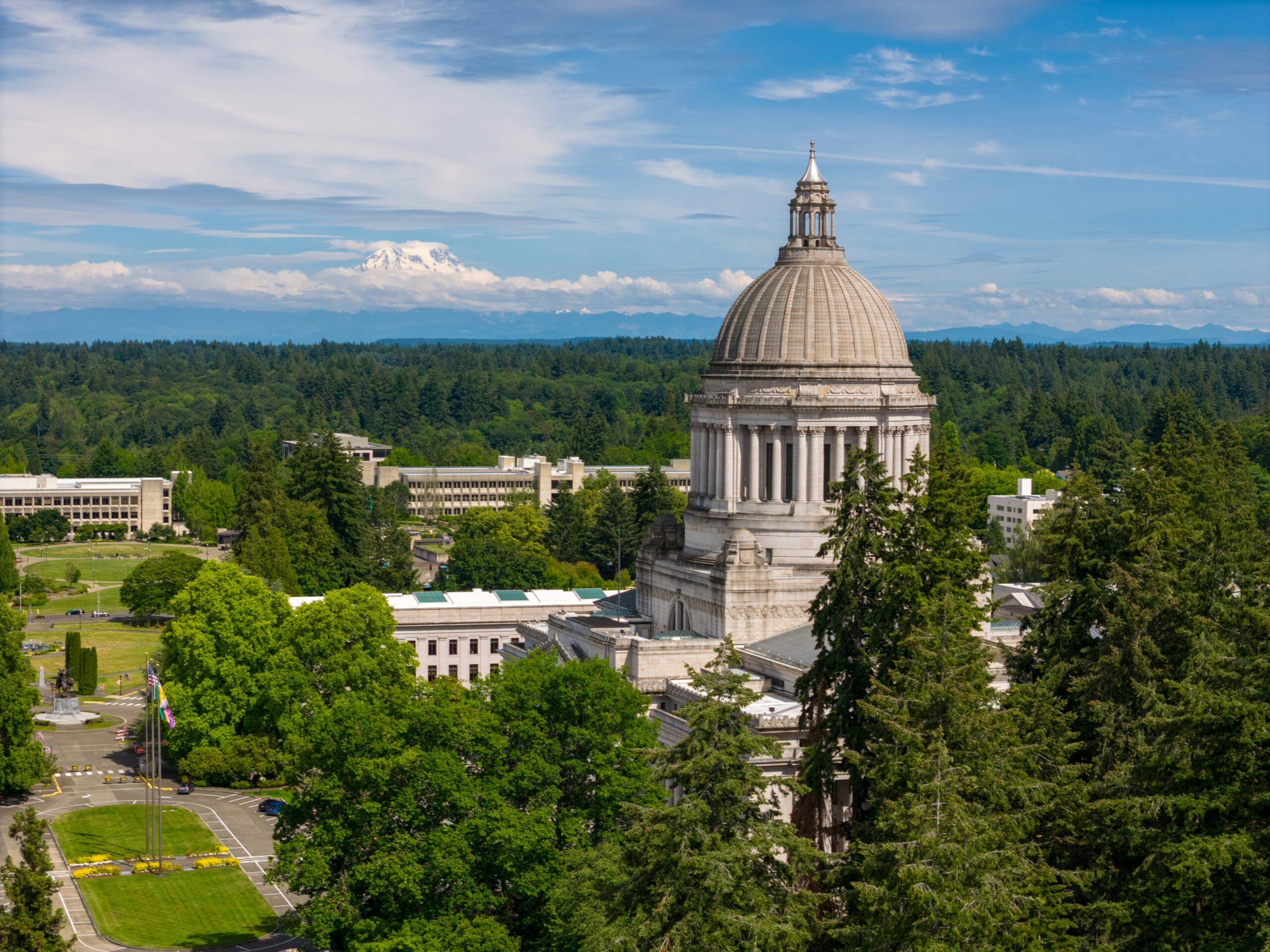
Legislative Session Recap
2025 Legislative Session Recap
September 4, 2025
Overview
The National Caucus of Environmental Legislators works with an extensive network of legislators across the country. Through individual outreach, various working groups, regional events, and more, NCEL works to provide resources for legislators’ interests.
Each year, NCEL staff produces a Legislative Session Recap showcasing trends and milestones in state-level environmental policy. Now more than ever, the action of states in the fight for a healthy environment and thriving communities is crucial.
Over the past year, federal executive action and the recent reconciliation bill have deprioritized renewable energy investments, taken steps to reduce the impact of the nation’s bedrock environmental laws, and scaled back various agencies’ ability to protect the health of our climate, air, water, wildlife, and communities.
Below are some of the major legislative trends and successful policies that states passed in 2025 to meet this moment and ensure a healthy environment for all.
Jump to a section: General Trends | Climate Accountability | Transmission & Utilities | Emerging Energy Technologies | Endangered Species | Outdoor Engagement | Habitat Connectivity | Plastic Pollution & Zero Waste | Toxic Chemicals & PFAS | Cumulative Impacts | Offshore Energy | Marine Biodiversity | Blue Economy
Most of the sections in this recap contain non-exhaustive lists of enacted legislation. You are encouraged to follow the link at the bottom of each section for a complete list of enacted legislation.
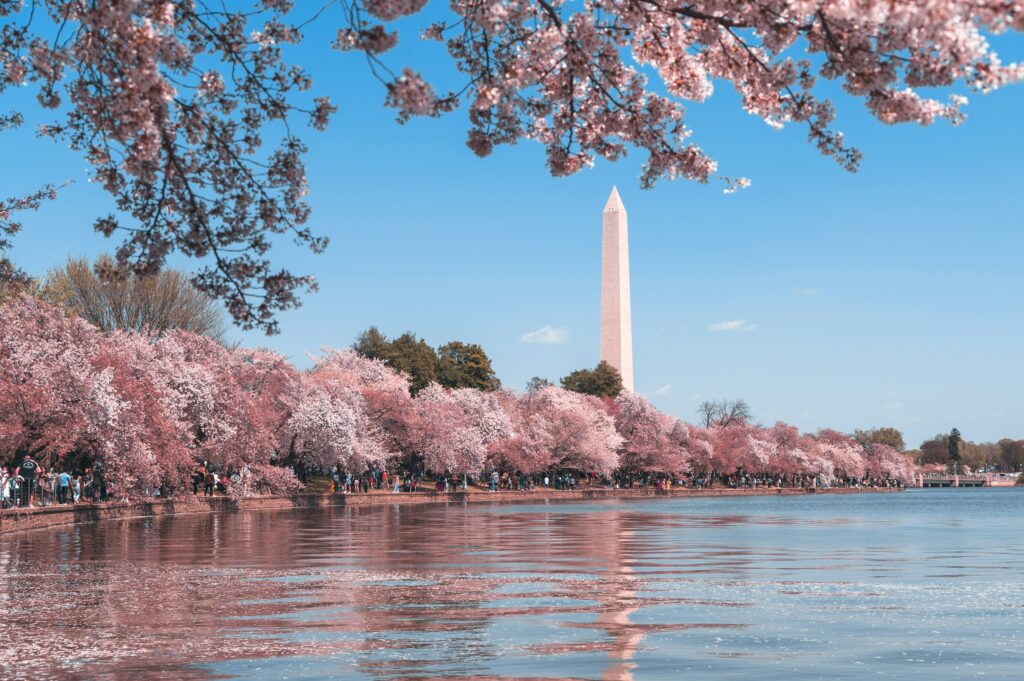
General Trends: Lasting State Solutions in an Era of Federal Retreat
As federal environmental protections face increasing uncertainty — from funding rollbacks to regulatory pauses — states are stepping up with innovative and lasting solutions. In 2025, state lawmakers across the country advanced a wave of policies that not only protect communities and ecosystems but also build durable, state-based pathways for environmental financing, governance, and accountability.
In response to federal rollbacks, states are modernizing wildlife governance, diversifying conservation and climate funding, and holding polluters financially accountable. Legislatures advanced climate resilience bills, reformed insurance systems to reflect environmental risks and aid in recovery, and expanded infrastructure financing through creative mechanisms like Extended Producer Responsibility for plastics. Coastal states filled increasing federal gaps in offshore policy, while nearly every state took action to increase outdoor access and enhance the long-term feasibility of the outdoor economy. Across the board, lawmakers prioritized equity, transparency, and sustainability to meet this moment of federal retreat and ensure permanent solutions for their constituents.
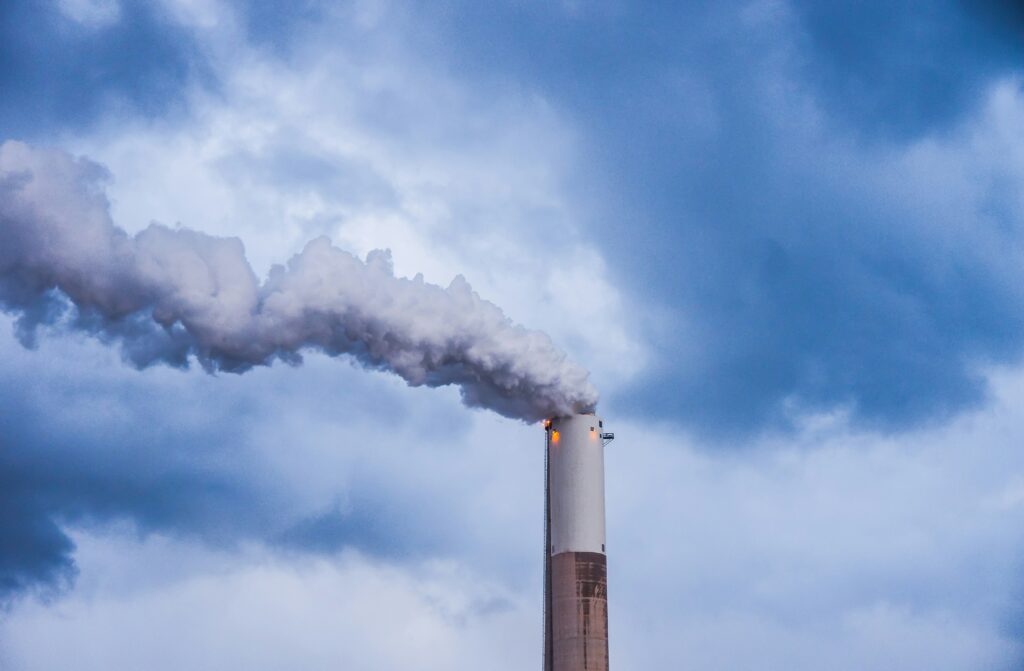
Climate Accountability
As climate disasters intensify, states are advancing bold legislation to address the impacts of these disasters and to hold major polluters accountable. New policies aim to modernize insurance systems to better reflect climate risks and support recovery. At the same time, climate superfund legislation requires fossil fuel companies to pay for climate damages, with funds directed toward adaptation, clean energy, and environmental justice. With federal climate funding increasingly uncertain, states are stepping up to ensure polluters — not communities — bear the costs. These efforts, alongside tools such as cap-and-invest programs and climate finance laws, mark a growing push for a fairer and more resilient future.
- 2025 Policy Impact: At least 23 states introduced 100 bills to modernize insurance and financial structures, along with holding polluters accountable for the costs of climate-related environmental risks. At least 9 bills were enacted across 7 states.
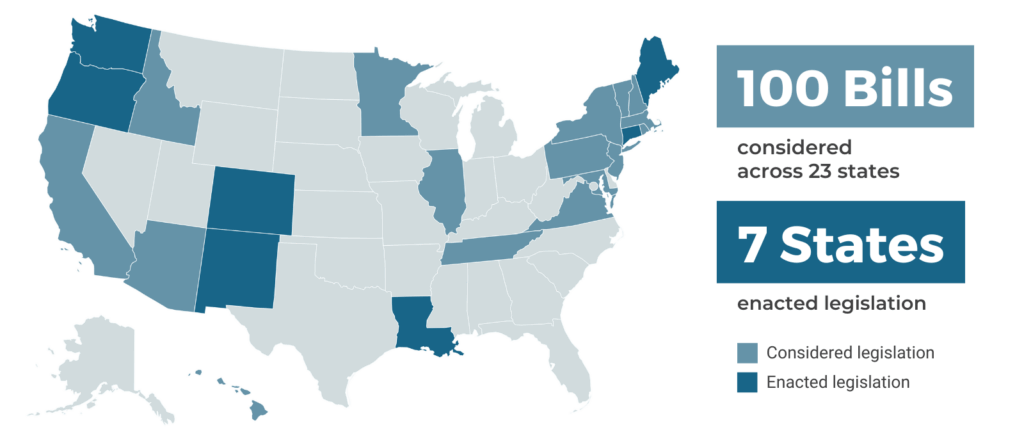
Climate Accountability Legislation
- Colorado HB 1182: Requires property insurers to transparently disclose and account for wildfire risk models and mitigation actions while also providing policyholders with clear information, appeal rights, and incentives for wildfire risk reduction.
- Colorado SB 028: This law changes how often Colorado’s public employee retirement system (PERA) is reviewed. It requires financial studies and audits to happen every four years instead of every five, and ensures audit results are based on the most recent study, with an independent review also happening every four years.
- Oregon HB 2081: Directs the Oregon Investment Council and the State Treasurer to take actions to manage the risks of climate change for the Public Employees Retirement Fund, a pension plan specifically designed for individuals employed in the public sector.
- Maine LD 1/SP 29: Establishes the State Resilience Office and creates programs to fund improved resiliency from future extreme weather events.
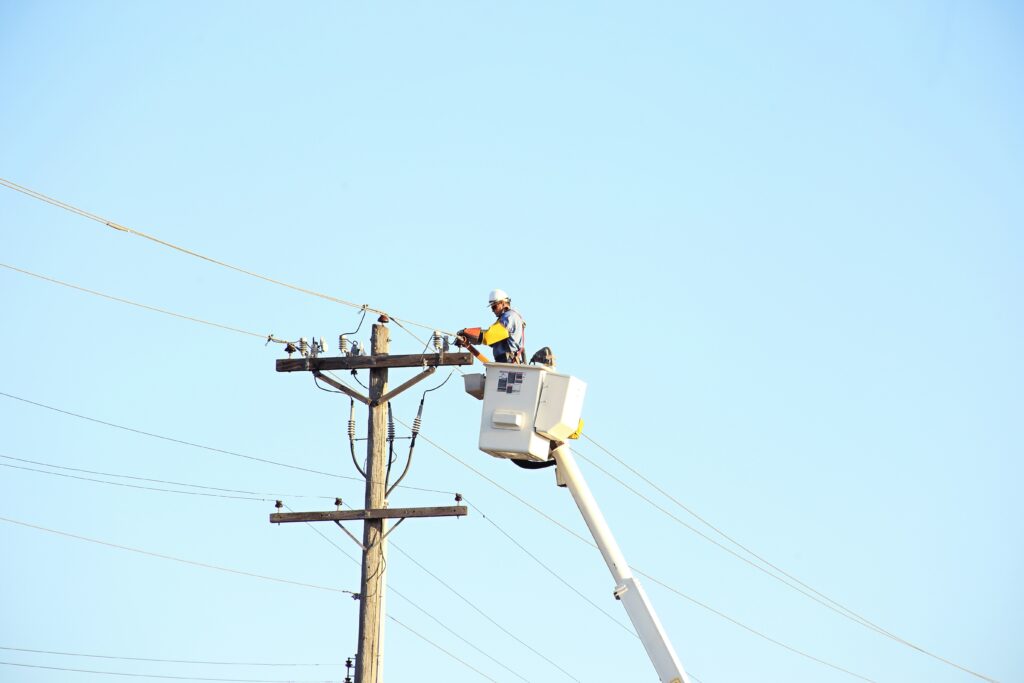
Transmission & Utilities
As demand for clean and reliable electricity grows, states are stepping up to modernize and expand the power grid. In 2025, at least 20 states pursued laws to promote grid-enhancing technologies (GETs), which boost transmission capacity quickly and affordably without building new infrastructure. Long-term grid planning is gaining traction as states like Oregon, Washington, and Montana introduced bills to establish transmission authorities — aiming to lead coordinated development efforts in regions that currently lack a formal regional planning structure. States are stepping up to address grid challenges — rising congestion, limited renewable energy capacity, and fragmented oversight — by advancing proactive transmission policies that boost coordination, reliability, and future readiness.
In 2025, 27 states considered bills targeting data center impacts, while six sought greater transparency in regional transmission organization’s (RTO) decision-making. Legislators are also embracing emerging technologies like microgrids and Virtual Power Plants to enhance resilience and ease grid stress.
- 2025 Policy Impact: At least 40 states introduced 332 bills to reform electric utilities and modernize the power grid. A total of 56 bills were enacted into law across 21 states.
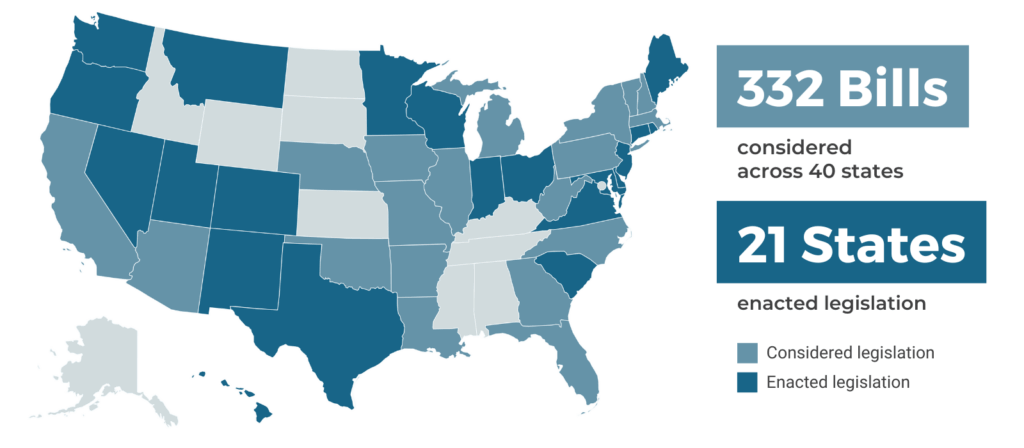
Transmission & Utilities Legislation
Utilities
- Hawai’i SB 589: Requires the Public Utilities Commission to set installation goals and compensation rates for customer-sited distributed energy resources, establish tariffs for grid services and microgrids, clarify microgrid utility status, and implement policies for renewable energy wheeling.
- Maine LD 186: Authorizes the Public Utility Commission to implement time-of-use (TOU) rates for electricity customers and requires the Commission to consider the impacts of a TOU rate on vulnerable populations prior to its implementation.
- Maryland HB 0121: Requires utilities to submit an annual report on their votes cast in any PJM meeting and include an explanation for how that vote supported the public interest.
- Nevada AB 452: Requires the Nevada Public Utilities Commission to investigate cost-sharing adjustments, mandates utility refunds for certain overcharges, and updates rules for public utility applications.
- New Jersey S 3308: Requires utilities to approve the interconnection requests of solar and batteries 20 MWs or less, unless the interconnection would be unsafe or if the application is incomplete.
- New Mexico HB 91: Authorizes utilities to create low-income electricity rates.
- Oregon HB 3681: Streamlines Energy Facility Siting Council site certificate process with 12-month final orders, Supreme Court appeals, minor boundary changes without amendments, and simplified PUC review for transmission lines.
- Oregon SB 688: Allows the Public Utility Commission to adopt, and provides resources for, performance-based regulation for utilities.
- Texas HB 5323: Creates the Texas Energy Waste Advisory Committee to recommend ways to reduce energy waste, boost efficiency, and improve demand response programs.
- Virginia SB 1100: Creates a three-year, 450 MW Virtual Power Plant pilot program – the largest in the nation. After three years, the law directs the pilot to be adopted as a formal program.
Transmission
- Colorado HB 1292: Permits transmission developers to co-locate high voltage lines in state highway rights-of-way, requires public reporting, tribal consent, developer compensation, and mandates a state study to identify suitable corridors.
- Delaware HJR 3: Directs all Delaware electric utilities to participate in a study analyzing the costs, benefits, feasibility, and barriers of adopting grid-enhancing technologies.
- Indiana SB 0422: Requires utilities to evaluate the use of Grid Enhancing Technologies in Integrated Resource Plans. Directs the Utility Regulatory Commission to study and report on the deployment of GETs; authorizes utilities to recover costs of deploying GETs.
- Maine LD 810: Clarifies that a transmission line does not require legislative approval after the Public Utilities Commission’s review process.
- New Mexico HB 93: Requires utilities to include grid-enhancing technology (GETs) projects in planning. Allows utilities to recover the cost of deploying GETs through customer rates.
- Ohio HB 15: Utilities must evaluate, and report on, the efficacy of deploying Grid Enhancing Technologies when applying for a Certificate of Public Convenience to build a new transmission line.
- Oregon HB 3336: Requires power companies to file and update cost-effective grid-enhancing technology plans with the PUC, mandates local governments to review related applications using clear criteria without hearings, and sets a state policy for electric transmission.
- Utah HB 212: Expands and encourages deployment of advanced transmission technologies to increase grid capacity, efficiency, and reliability.
- Virginia HB 1822: Requires the State Corporation Commission to consider the use of advanced conductors when evaluating a new transmission line over 138 kV.
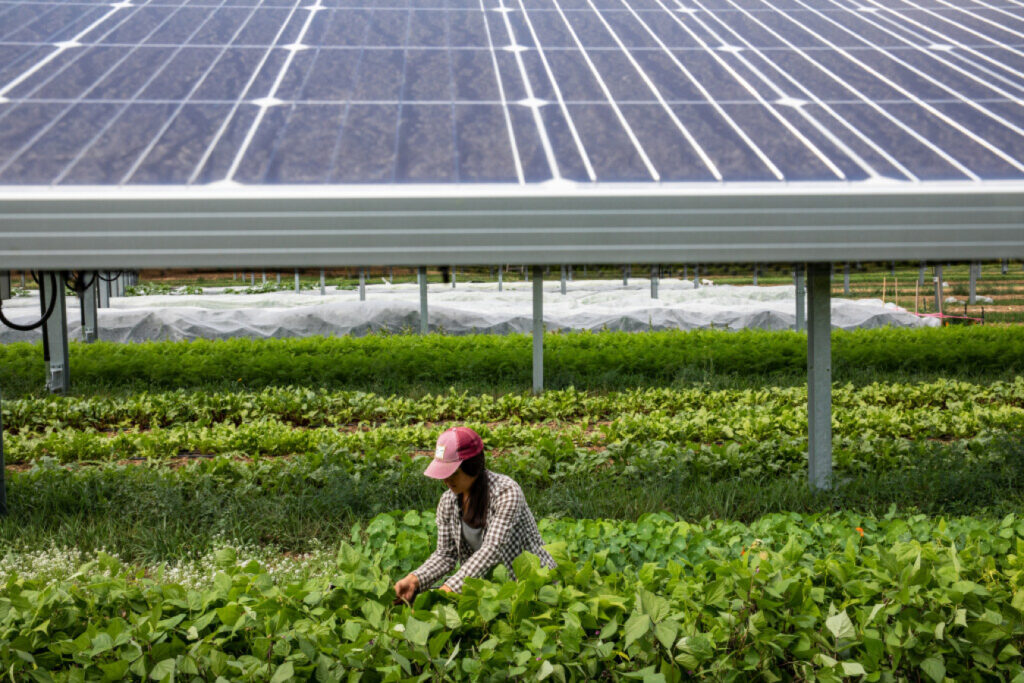
Emerging Energy Technologies
States are accelerating the shift to a renewable energy future by investing in emerging technologies like agrivoltaics, geothermal, and energy storage. These tools are not only essential for reducing emissions and addressing climate change but also for improving energy resilience, affordability, and equity.
In 2025, legislators are expanding support for technologies like geothermal, which provides 24/7 renewable energy. As more states leverage federal funding and explore new models, community-focused energy solutions are becoming key pillars in the nation’s energy transition.
- 2025 Policy Impact: At least 27 states considered 94 pieces of legislation to invest in and deploy emerging energy technologies. At least 16 states enacted 21 of these bills.
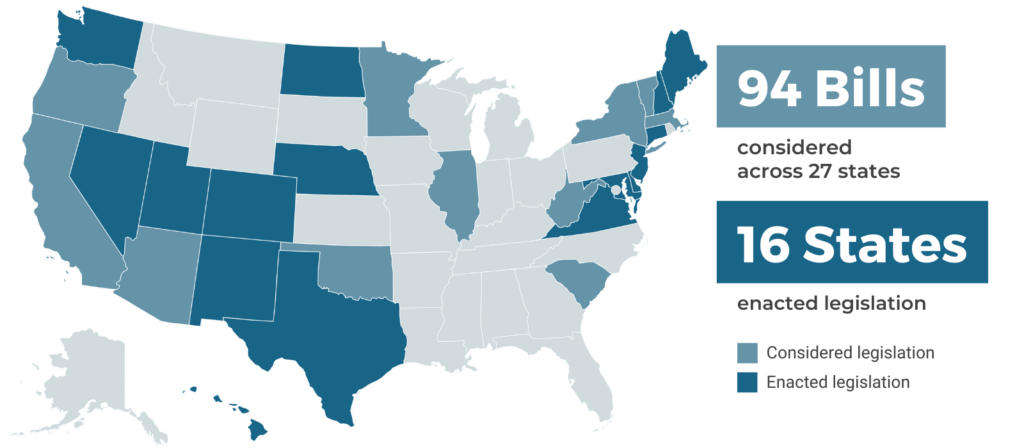
Emerging Energy Technologies Legislation
- Colorado HB 1165: Establishes a regulatory and funding framework for the management of underground energy resources, such as geologic storage of carbon dioxide (CO2) and geothermal.
- Hawai’i HCR 58: Requests the formation of a Geothermal Energy Working Group to evaluate the regulatory and policy landscape surrounding geothermal energy in Hawai’i.
- Nevada AB 479: Explicitly defines agrivoltaics and classifies agrivoltaic land as agricultural property so property owners can receive the same property tax benefits as traditional agricultural land.
- New Hampshire SB 233: Establishes the energy reliability and large-scale storage task force to develop market-based solutions and programs to incentivize the development and connection of large-scale energy storage systems.
- New Mexico HB 361: Authorizes the conversion of oil or gas wells into a facility that provides energy storage or develops geothermal energy.
- North Dakota SB 2360: Mandates a study to assess the feasibility of developing geothermal energy in the state.
- Texas HB 4370: Makes geothermal infrastructure eligible for Public Improvement Projects, allowing utilities, municipalities, and other entities to own and operate geothermal infrastructure and to fund geothermal projects with public bonds.
- Utah HB 350: Modifies the High Cost Infrastructure Development Tax Credit Act to include district energy systems that use thermal energy sources to provide space heating, hot water, or space cooling.
- Utah SB 213: Provides tax exemptions for operators of facilities that manufacture energy storage devices or equipment.
- Virginia SB 1316: Expands Virginia’s Renewable Energy Portfolio Standard to include geothermal resources.
- Washington HB 1514: Encourages the deployment of low-carbon thermal energy networks by integrating them into existing utility regulations.

Endangered Species
With one-third of U.S. wildlife at risk of extinction and nearly every county home to threatened or endangered species, state legislators are stepping up to protect biodiversity and prevent species loss. Drivers such as habitat destruction, invasive species, overexploitation, and climate change continue to put critical plant and animal species at risk, many of which provide essential ecosystem services that support human health, agriculture, and clean water.
In response, states across the nation have enacted their own state endangered species laws (SESAs), modeled after the federal Endangered Species Act, to address local conservation needs. In 2025, states have introduced bills that strengthen protections, improve monitoring, and streamline recovery efforts. Across the country, lawmakers are also expanding partnerships with agencies, building bipartisan coalitions, and increasing funding to scale conservation programs. As federal funding remains uncertain, state leadership is proving essential to preventing extinction and preserving natural heritage for future generations.
- 2025 Policy Impact: At least 19 states introduced 38 bills to address local wildlife conservation needs through State Endangered Species laws (SESAs). A total of 12 bills were enacted into law across 8 states.
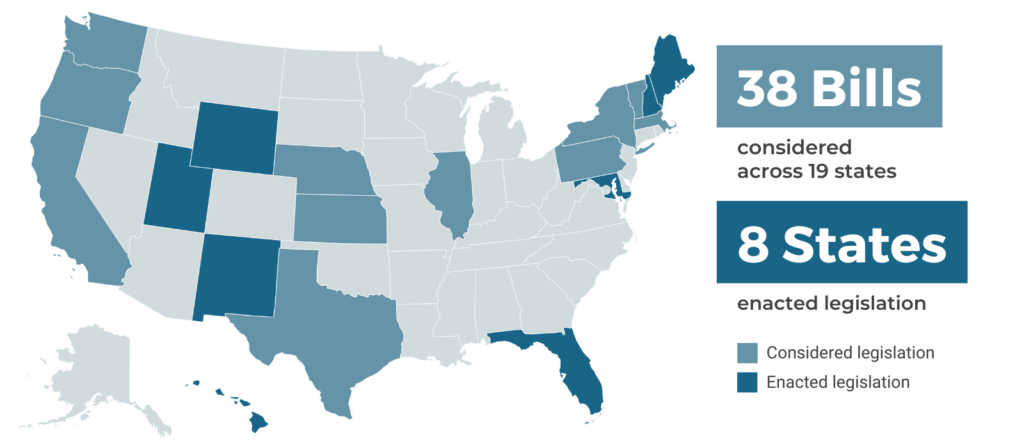
Endangered Species Legislation
- Florida SB 7000: Extends the exemption protecting site-specific location information for endangered species from public records disclosure.
- Hawai’i SB 849: Prohibits harming the ʻIo–Hawaiian hawk–and increases penalties for taking native Hawaiian species.
- Maine LD 95: Expands confidentiality regarding location data for threatened and endangered species to include species of special concern.
- New Hampshire HB 2: Requires the Department of Environmental Services to adopt rules and review procedures such that actions of state agencies do not jeopardize the existence or habitats of species protected under the Endangered Species Conservation Act.
- New Hampshire SB 235: Enables funds from the Pitman-Robertson Act to be spent by the Fish and Game Department on threatened and endangered species in New Hampshire.
- New Mexico HB 2: Appropriates over $10.5 million over three years to support agency capacity building to conserve species of greatest conservation need, including the American beaver.
- New Mexico SB 5: Reforms the state wildlife commission appointment processes, term limits, and other operational processes.
- Utah HB 378: Creates a new tax on direct current transmission and radioactive waste facilities to help fund the Endangered Species Protection Account.
- Wyoming SF 0179: Establishes a credit-based system to balance development with long-term sage-grouse habitat protection, setting rules for mitigation responsibilities, service areas, and regulatory oversight.

Outdoor Engagement
Spending time in nature has proven health, educational, and economic benefits, yet most Americans spend the majority of their time indoors. These benefits are not distributed equally: communities of color, low-income neighborhoods, and people with disabilities continue to face the greatest barriers to nature access.
In 2025, states reaffirmed their commitment to addressing these disparities and expanding outdoor engagement. Despite challenges like divided legislatures, budget constraints, and federal uncertainty, outdoor policy has remained a bipartisan priority. This year’s legislative trends have centered around outdoor education, disability access, trail connectivity, and sustainable recreation funding.
- 2025 Policy Impact: At least 45 states and Washington D.C. introduced 300 bills to increase outdoor access and equity. A total of 67 bills were enacted across 28 states and territories.
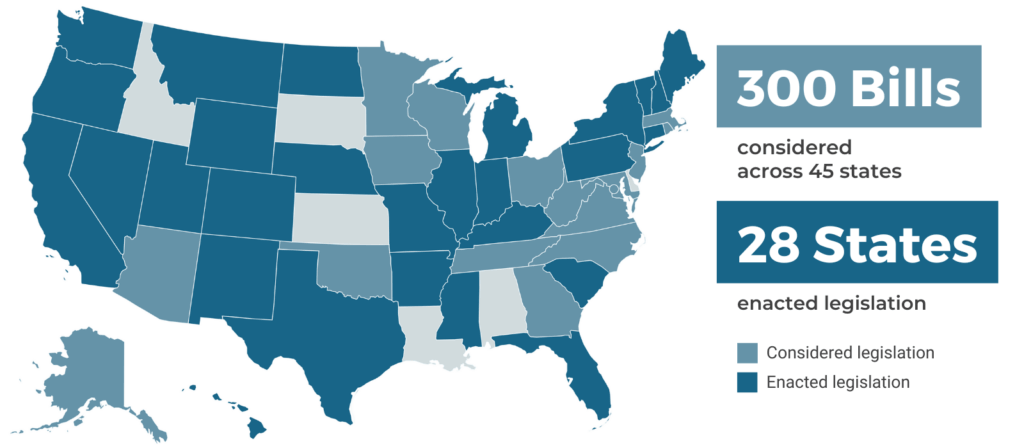
Outdoor Engagement Legislation
- Arkansas HB 1607: Creates the Office of Outdoor Recreation within the Department of Parks, Heritage, and Tourism, making an existing office permanent.
- Colorado HB25-1061: Establishes a $4 million Community Schoolyards Grant Program funded by the Local Government Severance Tax Fund to develop green, community-based schoolyards, prioritizing underserved areas.
- Colorado HB25-1163: Guarantees the rights of enrolled members of the Southern Ute Indian Tribe and enrolled members of the Ute Mountain Ute Tribe to enter state parks without having to pay an entrance fee. Tribal nations often maintain treaty rights to freely access land, Tribes maintain significant historical and cultural ties to land, and entrance fees serve as a financial barrier for some Tribal citizens.
- Florida H.B.209 / S.B. 80: Prioritizes and defines conservation-based public outdoor recreation use in state parks to prevent the conversion of parks’ natural spaces into paved sport courts.
- Indiana H.B.1616: Urges a study on the economic value and impacts of public recreational lands. Outdoor recreation contributes $1.2 trillion in economic output nationally, which largely originates in the quality and availability of public recreational lands.
- Maine LD 895: Establishes an Outdoor School for All program to provide immersive multi-day outdoor education experiences to students in grades four to eight.
- Montana SB 238: Establishes a program funded by optional donations on hunting licenses that supports bowhunters with disabilities by helping nonprofits acquire modified archery equipment.
- New Mexico HM 31: Expands citizen science by establishing a “Citizen Science Day,” and integrating citizen science into state agencies, prioritizing youth engagement and environmental data collection.
- Nevada SB 405: Creates the Transit-to-Trails Task Force to improve public transit access to outdoor recreation areas.
- Texas H.B.4230: Establishes the Bicentennial Trail, a network of hike and bike trails connecting significant historic and cultural sites as well as existing trails to promote outdoor recreation, environmental stewardship, and the state’s historical and cultural heritage.
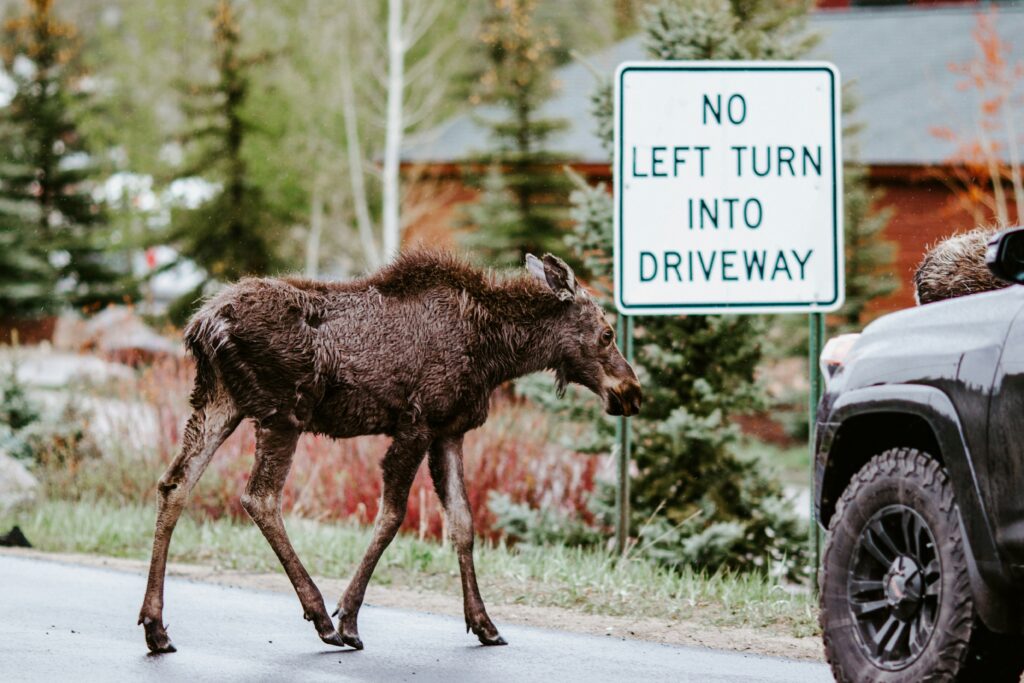
Habitat Connectivity
Roads and other infrastructure continue to fragment wildlife habitats across the U.S., disrupting migration, increasing collisions, and accelerating biodiversity loss. Each year, vehicle-wildlife collisions result in up to 2 million accidents, 26,000 injuries, and $8 billion in damages. In 2025, Maryland passed HB 731/SB 635 to improve habitat connectivity and reduce wildlife-vehicle collisions by creating a Connectivity Coalition, requiring wildlife-focused planning, and boosting oversight and funding. Maryland joins 24 other states advancing habitat connectivity, working to restore wildlife corridors, protect drivers, and strengthen ecosystems.
- 2025 Policy Impact: At least 26 states introduced 66 bills to improve wildlife habitat connectivity. A total of 18 bills were enacted into law across 12 states.
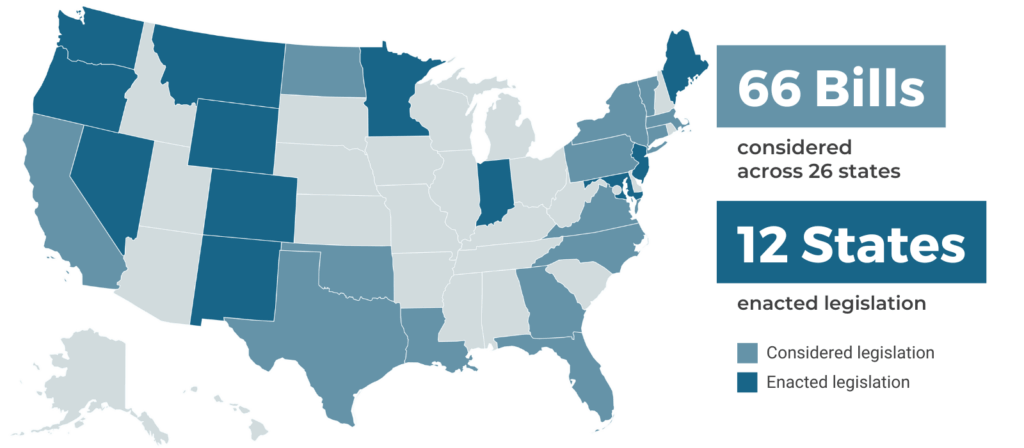
Habitat Connectivity Legislation
- Colorado HB 1093: Broadens the definition of anti-growth laws to restrict local limits on residential density unless offset elsewhere, exempts areas near wildlife crossings, and allows municipalities to seek judicial review of land use initiatives.
- Colorado HB 1292: Allows high voltage transmission lines in state highway rights-of-way, sets permitting and reporting rules, requires Tribal consent on reservations, and mandates a state study to identify suitable corridors.
- Indiana HB 1461: Modifies transportation funding and taxation by increasing county tax limits, adjusting fund distribution rules, expanding bonding authority, allowing interstate tolling requests, and linking grant eligibility to local tax adoption and pavement conditions.
- Maine LD 1340: Establishes a fund to provide grants for municipal road culvert upgrades, focusing on storm preparedness and habitat restoration, financed through proceeds from bond sales, appropriations, allocations, and contributions from both public and private sources.
- Maryland HB 0731: Creates the Maryland Connectivity Coalition to coordinate efforts to prevent habitat fragmentation for endangered wildlife, while granting the State Highway Administration final authority over wildlife crossing decisions.
- Montana HB 855 and HB 932: Creates the big game and wildlife highway crossings and accommodations account and allocates a portion of the state cannabis tax as a permanent funding source.
- Nevada AB 486: Updates transportation policies by requiring wildlife-related project reporting, revising Deputy Director qualifications, and modifying highway project proposal procedures to the Department’s Board.
- New Jersey S 3618: Appropriates $90,000 for the Wildlife Corridor Action Plan to be carried out by the Department of Environmental Protection and Department of Transportation.
- Oregon HB 2978: Updates a wildlife-vehicle collision reduction program by requiring improved reporting and the creation of an interagency advisory group.
- Wyoming SF 0088: Allocates funding for ten major natural resource and wildlife conservation projects in Wyoming, each exceeding $400,000, to support habitat restoration, invasive species control, and wildlife safety measures.
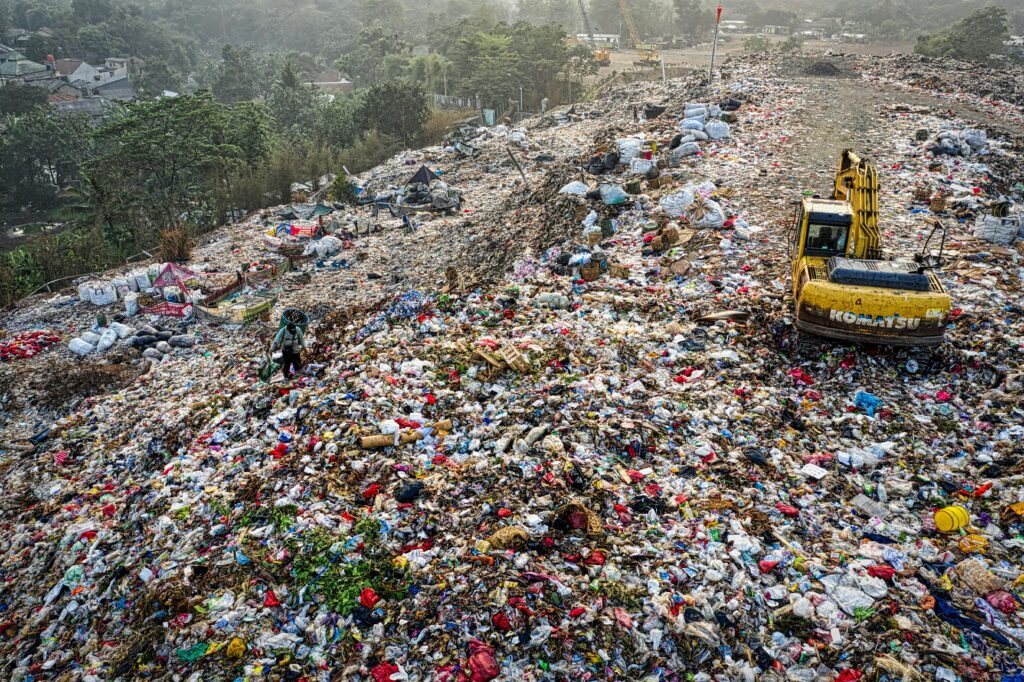
Plastic Pollution & Zero Waste
In 2025, states pursued diverse strategies to combat plastic pollution and advance zero-waste goals. Extended Producer Responsibility (EPR) remained a central focus, with legislation to hold producers accountable for the full lifecycle of packaging and paper products. Washington’s Recycling Reform Act (SB 5284), signed in May, establishes a statewide EPR program to boost recycling rates, reduce waste, and support reuse and refill systems, particularly in underserved communities.
Beyond EPR, states explored complementary pathways to reduce plastic waste. Several introduced or modernized Deposit Return Systems (“Bottle Bills”), expanded marine debris cleanup authorities, and strengthened litter enforcement. These efforts reflect a growing recognition that meaningful progress on plastic pollution is highly effective when solutions span the entire plastic lifecycle — from production to waste management.
- 2025 Policy Impact: At least 31 states introduced 164 bills to reduce plastic pollution. A total of nine bills were enacted across five states.
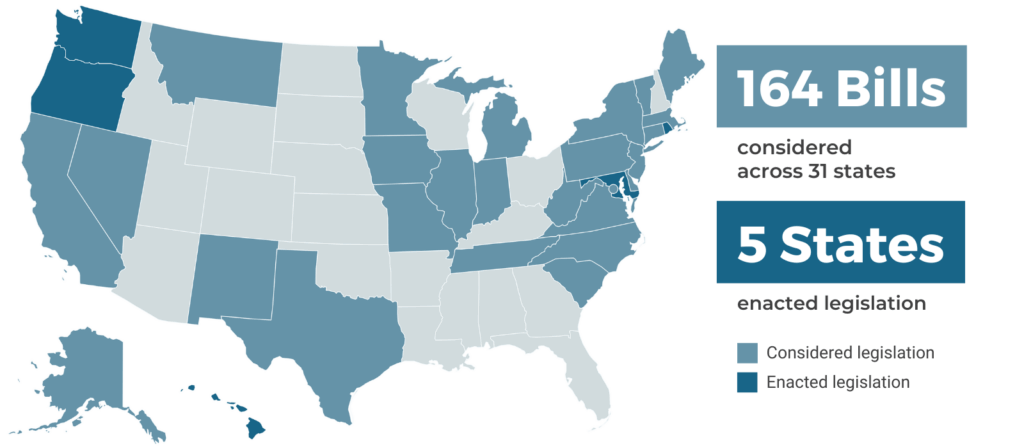
Plastic Pollution & Zero Waste Legislation
- Hawai’i HB 750: Requires the Department of Health to conduct a statewide Extended Producer Responsibility (EPR) needs assessment on waste reduction and recycling for packaging and paper products, establish an advisory council, hold a public hearing, and submit findings to the Legislature by the end of 2027.
- Maryland SB 0901: Requires producers of covered packaging and paper products to submit a producer responsibility plan to the Department of the Environment by July 1, 2028, and every five years after, or develop an alternative program, with associated fees payable by producer responsibility organizations.
- Oregon SB 795: Updates abandoned vessel laws by defining offenses, allowing authorized removal of marine debris without notice, imposing fines for vessel abandonment, and empowering the Department of State Lands to manage cleanup efforts.
- Oregon SB 992: Directs the Oregon Liquor and Cannabis Commission to study and modernize the Bottle Bill, authorize new redemption center types, adjust convenience zone rules, and update beverage container return policies.
- Rhode Island SB 996/HB 6207: Mandates a statewide analysis for implementing a beverage container redemption and recycling plan, emphasizing producer responsibility and oversight.
- Washington HB 1293: Updates penalties for littering to include fines covering costs of cleanup and community service requirements.
- Washington SB 5284: Requires extended producer responsibility programs for consumer packaging and paper products.

Toxic Chemicals & PFAS
In 2025, states are stepping up efforts to restrict PFAS “forever chemicals” in consumer products, focusing especially on personal care items. New York passed legislation banning PFAS and other harmful substances in menstrual products like tampons, aiming to reduce health risks linked to these toxins. New York is among at least 37 states considering PFAS restrictions in 2025, targeting menstrual products, cosmetics, food packaging, and children’s items. Other states have enacted laws addressing PFAS in consumer goods, firefighting materials, pesticides, and drinking water. This reflects growing state leadership to curb PFAS contamination and protect vulnerable communities nationwide.
- 2025 Policy Impact: At least 37 states introduced 202 bills to limit the use of PFAS chemicals. A total of 26 bills were enacted into law across 10 states.
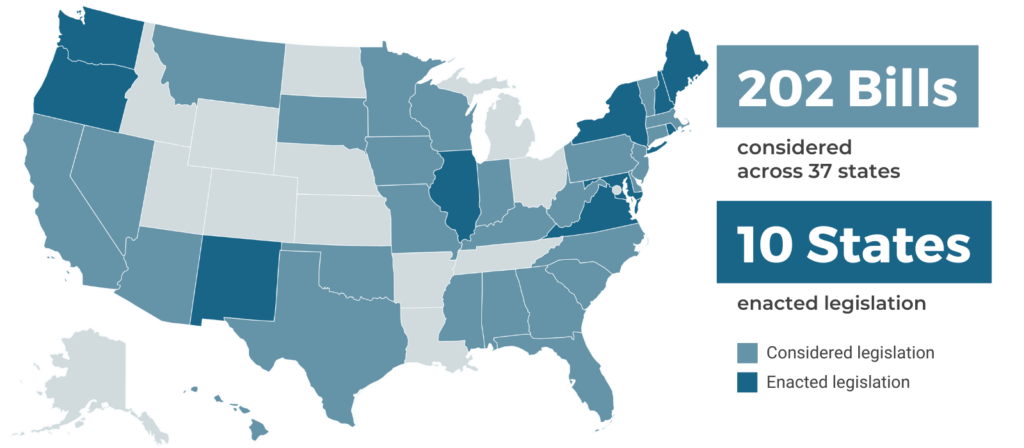
Toxic Chemicals & PFAS Legislation
Biosolids
- Oregon HB 2947: Directs the Oregon State University Extension Service and the College of Agricultural Sciences of Oregon State University to study the distribution and occurrence of PFAS found in biosolids applied to agricultural fields that do not produce crops intended for human consumption.
- Rhode Island S.B. 650 / HB 5844: Beginning on September 1, 2025, people seeking to apply biosolids to lands must test the biosolids for PFAS contaminants on a quarterly basis and report those findings to the state Department of Environmental Management.
- Washington SB 5033: Prohibits the land application of biosolids containing PFAS.
Consumer Products
- Illinois HB 2516: Establishes that a person may not sell, offer for sale, or distribute for sale the following products if the product contains intentionally added PFAS: (1) cookware, (2) cosmetics, (3) dental floss, (4) juvenile products, (5) menstrual products, (6) intimate apparel, or (7) food packaging or food contact products.
- New Hampshire HB 167: Prohibits the sale of ski, boat, and board waxes that contain intentionally added PFAS.
- Vermont H 238: A phaseout of consumer products being manufactured, sold, and distributed containing added PFAS.
Firefighting
- Illinois HB 2409: Starting January 1, 2026, sellers of firefighting personal protective equipment containing PFAS chemicals must provide written notice to purchasers at the time of sale, stating it contains PFAS and why, and both parties must retain this notice for at least three years.
- Rhode Island SB 241 / HB 5019: Prohibits a manufacturer from manufacturing, knowingly selling, offering for sale, distributing for sale and using any firefighting personal protective equipment containing intentionally added PFAS as of January 1, 2027.
Drinking Water
- Maine LD 1326: Protecting the drinking water for consumers of certain water systems by establishing maximum contaminant levels (MCLs) for certain PFAS.
- Virginia HB 2050: Creates the Occoquan Reservoir PFAS Reduction Program to reduce excessive levels of PFAS in public drinking water derived from the Occoquan Reservoir.
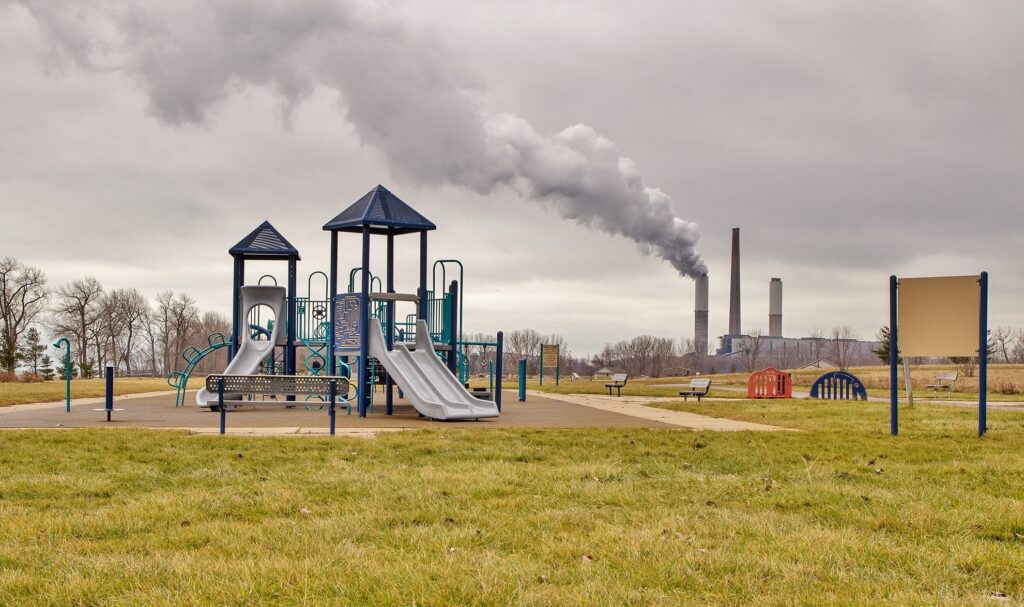
Cumulative Impacts
In 2025, states are advancing legislation to address cumulative impacts — where multiple sources of pollution and environmental stressors combine over time to harm human health, especially in environmental justice communities. These policies aim to tackle the compounded effects that disproportionately affect BIPOC, low-income, and limited English proficiency populations by regulating facility permitting, assessing multiple pollutants together, and incorporating social and health disparities into evaluations. Such holistic approaches recognize that combined pollution impacts can be additive or even synergistic, worsening health outcomes like asthma, diabetes, and hypertension in vulnerable communities. States are stepping up to better protect those facing decades of disproportionate environmental harm via cumulative impact laws.
- 2025 Policy Impact: At least 14 states introduced 30 bills to address the cumulative impacts of pollution. Notably this session, Wisconsin enacted new comprehensive cumulative impact protections.
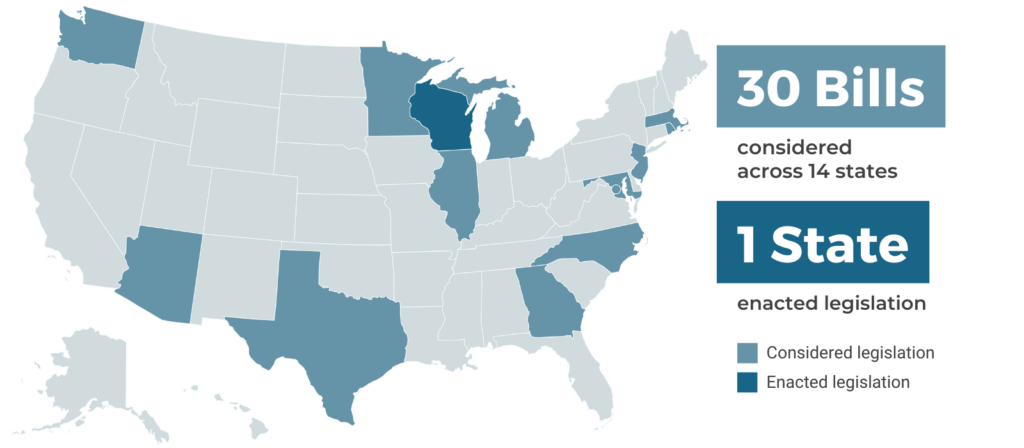
Cumulative Impacts Legislation
- Wisconsin SB 45: As part of a larger budget bill, this legislation establishes a process for identifying “covered communities” based on factors including income, housing, pollution, and traffic. The Department of Natural Resources is required to prepare an environmental impact report and hold a public hearing for facility permit applications wholly or partly in covered communities, and may deny a permit if it finds the facility constitutes an unreasonable risk to the environment and the health of the residents in the covered community.

Offshore Energy
In 2025, despite a federal pause on new offshore wind leasing, coastal states are moving forward with legislation to sustain momentum and prepare for future deployment. States have introduced at least three dozen bills focused on strengthening port infrastructure, workforce development, project planning, and permitting in state waters. These efforts position states to lead on offshore wind while federal actions remain on hold.
States are also passing preventative legislation to prohibit oil and gas drilling or exploration in state waters. Highlights include laws to advance infrastructure and workforce development and to authorize leasing in state-managed waters. As the offshore wind landscape shifts, states are ensuring they remain ready to deliver renewable energy, economic growth, and job creation.
- 2025 Policy Impact: At least 15 states introduced 38 bills to advance the offshore wind industry and regulate offshore drilling and exploration. A total of 10 bills were enacted into law across nine states.
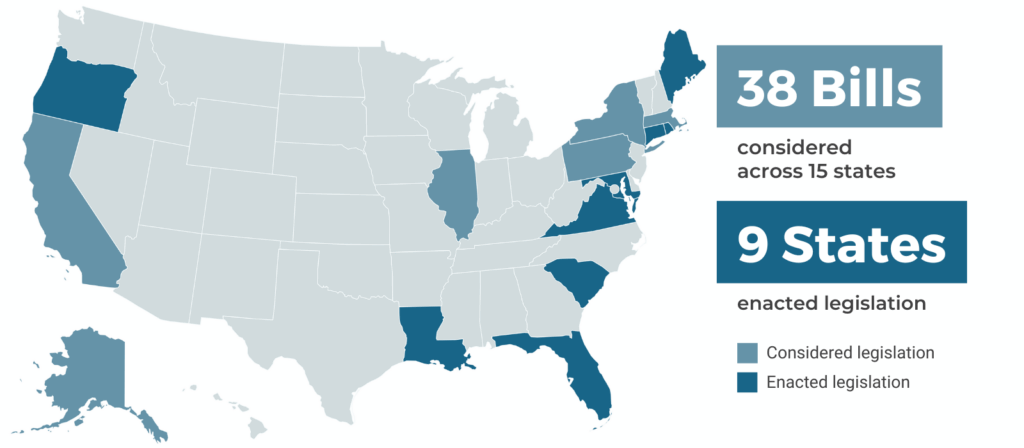
Offshore Energy Legislation
- Florida HB 1143: Restricts oil and gas drilling near national estuarine reserves, requires the Department of Environmental Protection to assess protection of natural resources from spills, and sets criteria for balancing these protections.
- Louisiana SR 81: Recognizes Tuesday, May 6, 2025, as Louisiana Renewable Energy Day.
- Maine LD 1868: Updates renewable and clean resource procurement laws to advance a renewable energy economy.
- Maryland SB 0829: Extending deadlines for the Minority Business Enterprise Program’s rules and related reports affecting public-private partnerships, offshore wind, gaming, and sports wagering.
- Oregon HB 3874: Increases from 50 megawatts to 100 megawatts the minimum size that a wind energy facility needs to be before a wind energy facility is required to obtain a site certificate from the Energy Facility Siting Council.
- South Carolina HB 4025: Prohibits the authorization or appropriation of state funds for the planning, permitting, licensing, or approval of projects that transport, develop, explore, or produce unrefined or unprocessed oil or gas from state waters.

Marine Biodiversity
As climate change and human activity increase pressure on marine ecosystems, protecting ocean biodiversity has become essential for climate resilience, sustainable economies, and healthy communities.
States are playing a key role by setting biodiversity targets, aligning conservation with climate goals, and advancing legislation to protect marine habitats. Coastal states are investing in coral reef restoration, expanding marine conservation areas, and connecting land and sea through ecological corridors. These efforts show how protecting biodiversity can also support local economies, enhance public safety, and advance environmental justice.
- 2025 Policy Impact: At least two states introduced six bills to promote marine biodiversity. Hawai’i and Washington passed three pieces of legislation to protect marine biodiversity in 2025.
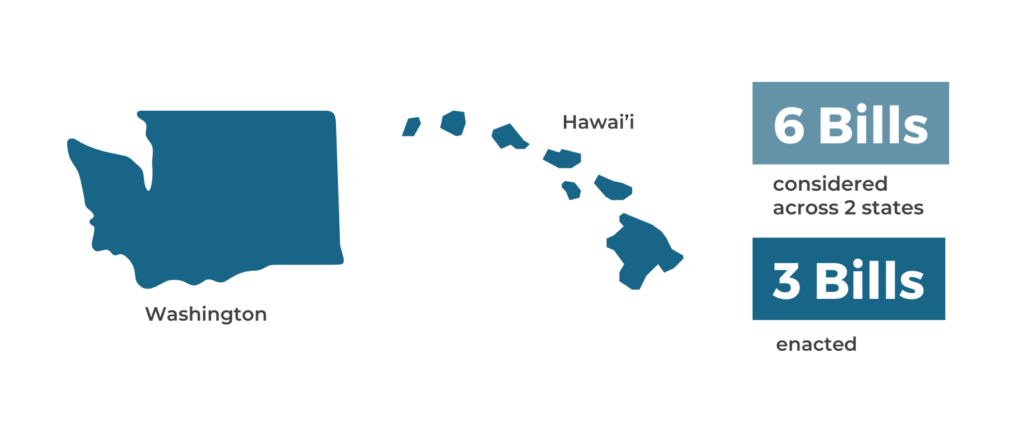
Marine Biodiversity Legislation
- Hawai’i HB 506: Appropriates funds for equipment for the Oahu Branch of the Division of Conservation and Resources Enforcement of the Department of Land and Natural Resources.
- Hawai’i SCR 157: Urges the state to adopt and support implementation of the United Nations’ agreement on conserving marine biodiversity in areas beyond national jurisdiction.
- Washington HB 1631: Establishes bull kelp forests as the official state marine forest.
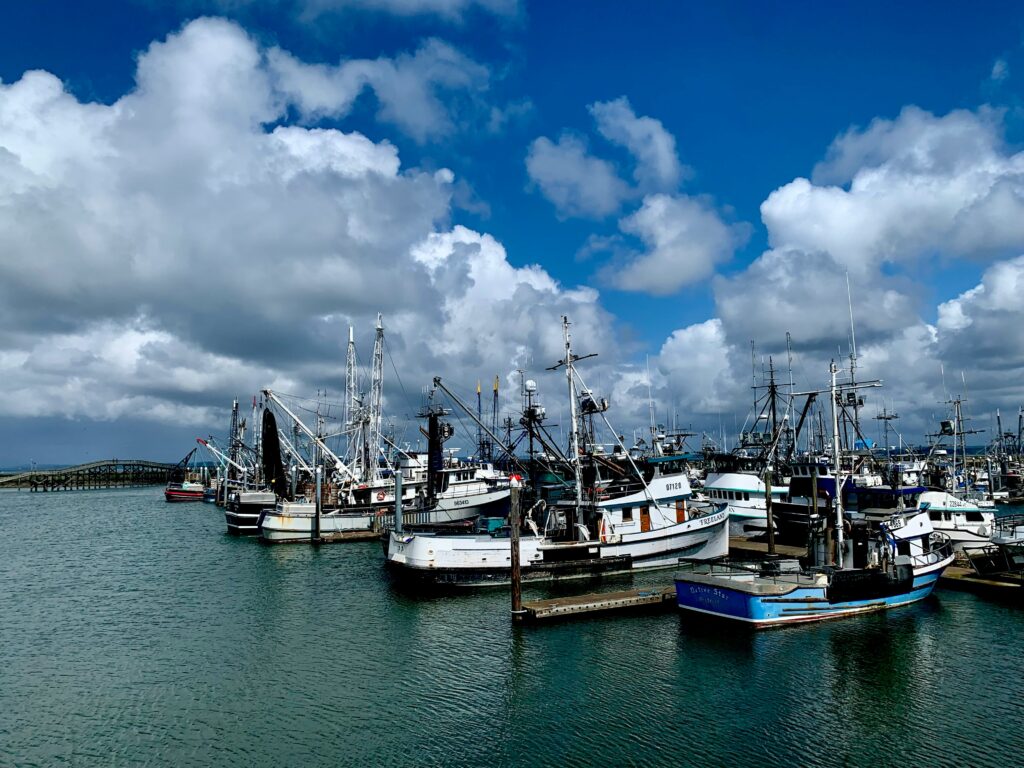
Blue Economy
In the 2025 legislative session, states advanced a range of policies to support the sustainable blue economy — defined as the responsible use of ocean and coastal resources for economic growth, environmental health, and community well-being. Legislation focused on sectors such as fishing, tourism, renewable energy, and marine research, while emphasizing conservation, innovation, and equitable economic development.
Common policy approaches included creating dedicated task forces or offices to coordinate blue economy strategies, incentivizing scientific research and workforce development, and establishing funding mechanisms for coastal restoration and climate adaptation. These efforts aim to balance economic opportunity with ocean health, protect coastal communities from climate risks, and ensure inclusive access to the benefits of ocean-based industries.
- 2025 Policy Impact: At least 15 states introduced 42 bills to advance the blue economy. A total of 12 bills were enacted into law across four states.
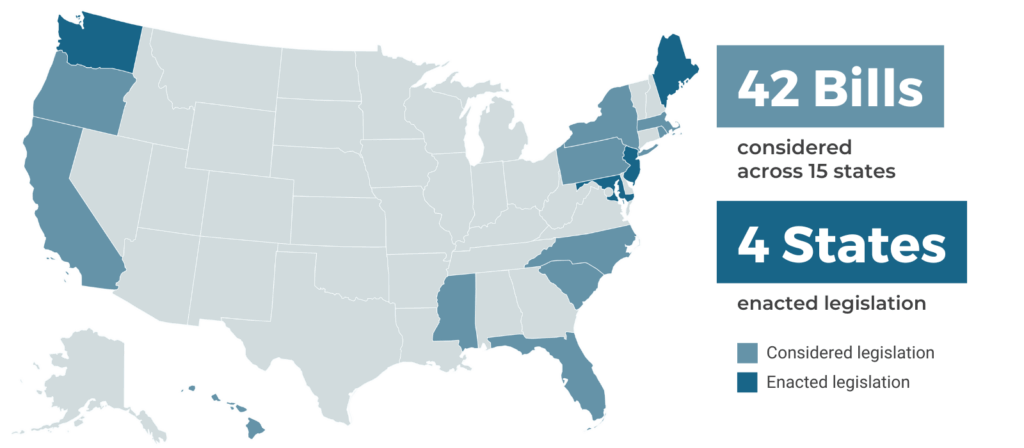
Blue Economy Legislation
- Maine LD 1023: Reestablishes the Blue Economy Task Force to support Maine’s emergence as a center for blue economy innovation and opportunity.
- Maine LD 1245: Creates a fund to spread awareness of Maine’s working waterfronts.
- Maine LD 1595: Strengthens working waterfronts against private nuisance complaints regarding aquaculture.
- Maine LD 1596: Directs the Department of Marine Resources to submit a report on the findings and recommendations of the aquaculture advisory council to support sea farmers.
- Maine LD 1858: Amends the Local Foods Fund within the Department of Education to require the fund be used to match $1 for every $2 a school administrative unit pays for food, including seafood, from a farmer, person who fishes commercially, aquaculture farmer, and more.
- Maryland HB 0397: Allows loans up to $25,000 for seasonal full-time jobs and shortens the eligibility period for seafood dealers from five to three years.
- New Jersey A 5687: Establishes the Next New Jersey Manufacturing Program to incentivize in-state manufacturing investments and job creation.
- Rhode Island H 5686: Directs the Coastal Resources Management Council to create a marine resources development plan to provide an integrated strategy for: improving the health and function of the state’s marine ecosystems; providing for appropriate marine-related economic development; and promoting the use and enjoyment of Rhode Island’s marine resources by the people of the state.
- Washington HB 1167: Directs the statewide career and technical education task force to consider educational opportunities for careers in maritime professions.
Keeping the Momentum Moving
As the Session Recap has shown, state legislators are meeting this unique moment with bold leadership and innovative solutions to ensure a healthy environment for all. NCEL is here to keep the momentum going. Whether you’re a lawmaker, partner organization, or concerned citizen, your voice and vision are essential. Explore our resources and bill tracking map, learn more about the issues we work on, and stay up to date on the latest policy news and upcoming NCEL events.